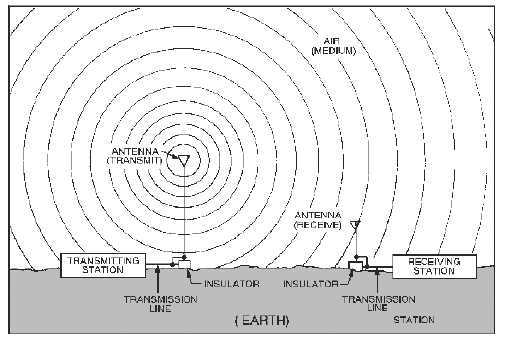1-34
THE BASIC ANTENNA
The study of antennas and electromagnetic wave propagation is essential to a complete
understanding of radio communication, radar, loran, and other electronic systems. Figure 1-23 shows a
simple radio communication system. In the illustration, the transmitter is an electronic device that
generates radio-frequency energy. The energy travels through a transmission line (we will discuss this in
chapter 3) to an antenna. The antenna converts the energy into radio waves that radiate into space from
the antenna at the speed of light. The radio waves travel through the atmosphere or space until they are
either reflected by an object or absorbed. If another antenna is placed in the path of the radio waves, it
absorbs part of the waves and converts them to energy. This energy travels through another transmission
line and is fed to a receiver. From this example, you can see that the requirements for a simple
communications system are (1) transmitting equipment, (2) transmission line, (3) transmitting antenna,
(4) medium, (5) receiving antenna, and (6) receiving equipment.
Figure 1-23.—Simple radio communication system.
An antenna is a conductor or a set of conductors used either to radiate electromagnetic energy into
space or to collect this energy from space. Figure 1-24 shows an antenna. View A is a drawing of an
actual antenna; view B is a cut-away view of the antenna; and view C is a simplified diagram of the
antenna.

